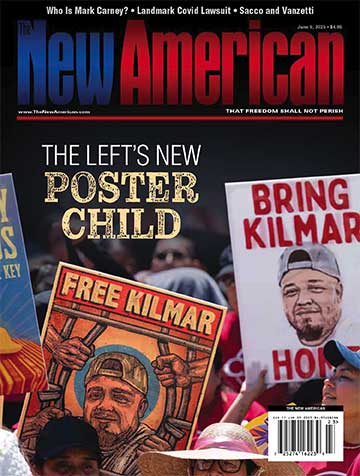
Will release of records about the Skull and Bones Yale fraternity stored at the George W. Bush presidential library reveal important information about the secretive society that counts so many prominent Americans on its roster of members?
The National Archives, which supervises the White House records stored at presidential libraries, including the George W. Bush Library, has announced that information located there has been requested under the Freedom of Information Act. It is rumored that Robert Gaylon Ross, author of Who’s Who of the Elite, has made the request. In his book, Ross examined such groups as the Council on Foreign Relations (CFR), the Trilateral Commission, the Bilderberg Group, and Skull and Bones. In excess of 1,000 pages of letters, memos, and other materials involving Skull and Bones, an organization in which Bush was a member, will be released, unless someone moves to block the disclosure.
While the CFR, the Bilderberg Group, and the Trilateral Commission are private organizations in which many of the world’s most powerful individuals meet in secret to discuss international issues, the Skull and Bones organization is a college fraternity found at only one institution of higher education: Yale.
Why is Skull and Bones often discussed in terms of powerful elites such as bankers, corporate heads, government leaders, media giants, and the like, when it is just a very tiny group found at only one college, albeit an elite Ivy League school? It appears that the group is more concerned with the success of its members — after they finish college. And they can certainly boast of prominent success by those who have held membership in the “fraternity.”
Many of the alumni of Skull and Bones have served in the highest levels of American government, including presidents, CIA directors, Supreme Court justices, secretaries of state and defense, and presidential candidates. In 2004, both incumbent President George W. Bush, a Republican, and his Democratic opponent John Kerry were members of Skull and Bones. While this fact generated something of a stir, neither candidate would discuss the group, arguing that it was “secret.”
When Kerry was asked what it meant that both he and Bush were Bones alums, he replied, “Not much, because it’s a secret.” Bush briefly addressed his membership in his autobiography, noting that in his senior year, “I joined Skull and Bones, a secret society; so secret, I can’t say anything more.”
Other prominent members have included both President George H.W. Bush; James Jesus Angleton, who is credited with “mothering” the Central Intelligence Agency (CIA); William F. Buckley, Jr.; Secretary of War Henry Stimson; multiple Supreme Court justices; Austan Goolsbee, chairman of President Barack Obama’s Council of Economic Advisors; Frederick Smith, the founder of FedEx; Harold Stanley, founder of Morgan Stanley; Secretary of Defense Robert Lovett; and both President William Howard Taft and his son, Senator Robert A. Taft. In fact, President Taft’s father, Alphonso, was among the group’s founders. Besides the Tafts, the group has included Rockefellers and Pillsburys among its members.
The organization has included prominent public office holders over the years, and even famous football coaches, including Walter Camp and Amos Alonzo Stagg. Charles Seymour, a founding member of the CFR, was a member, as was Winston Lord, who held the position of CFR chairman. Other members who have achieved high positions in American business, politics, and society include David McCullough, the famous historian who wrote the best-selling biography of John Adams; liberal columnist Dana Milbank; George H.W. Bush’s father, Senator Prescott Bush; William P. Bundy, who coordinated the Bay of Pigs invasion; diplomat and international banker Averill Harriman; and former Senator David Boren (who was on the Senate Intelligence Committee and is a good friend of former CIA Director George Tenet).
The secret society began at Yale in 1832 in an apparent dispute between Yale debating societies, with the original name of Order of the Skull and Bones. Skull and Bones Hall at Yale is also known as “The Tomb.” Over the years, the group has been rumored to have stolen the skulls of Martin Van Buren, Pancho Villa, and Geronimo. Detractors have even charged that the fraternity has used such skulls in occult practices.
Those who ascribe more nefarious origins and motivations to the group connect them to the Bavarian Illuminati, it having been founded by German university alumni. Perhaps most interesting is the group’s alleged connection to the founding of the CIA, since James Angleton, considered a founder of the CIA, was a Bones member, and several other members have been in the CIA in one capacity or the other over the years. For example, George Herbert Walker Bush was a director of the CIA, and William F. Buckley, Jr., founder of National Review magazine, was also a member.
Antony Sutton, a scholar at the Hoover Institution of Stanford University, wrote several books about the connections of Wall Street — such as Wall Street and the Bolshevik Revolution; Wall Street and FDR; and Wall Street and the Rise of Hitler. He also penned America’s Secret Establishment: An Introduction to the Order of Skull and Bones, in which he asserted that Skull and Bones was a recruiting ground for a global conspiracy for world government.
Of course, the grandson of founder Alphonso Taft, Senator Robert A. Taft, was a prominent leader in the non-interventionist wing of the Republican Party in the 1940s and early 1950s, and his membership would seem to argue against the conspiracy theory of Skull and Bones. And his father, President William Howard Taft, was a staunch opponent of the creation of the Federal Reserve System.
But, then again, those who argue for Skull and Bones as an important recruiting ground for the American elite might counter that not every member of Skull and Bones is recruited into the American establishment, and some of its members live out the rest of their lives in relative obscurity.
And Taft certainly could have been president, had he been willing to adopt a more “internationalist” tone. In June of 1940, Senator Taft was invited to an exclusive dinner party hosted by the publisher of the New York Herald-Tribune, Ogden Reid and his wife. Also present were Thomas Lamont, a senior partner at J.P. Morgan & Company, and his wife; Lord Lothian, then-ambassador to the United States from Great Britain; Mr. And Mrs. John Pillsbury of the Minneapolis milling family; and Mr. And Mrs. Wendell Willkie.
Lord Lothian made a strong pitch that the United States should go all-out at once to aid Britain in the war. Lamont and Willkie strongly endorsed Lothian’s message. When Taft was called upon, he told the party that he could add nothing to his recent remarks in the Senate, where he had said that Americans did not want to go to war to beat a totalitarian system in Europe if they were to get socialism in America when it was all over.
A few days later, the New York Herald-Tribune announced its support for Willkie, calling him “Heaven’s gift to the nation in its time of crisis.” Perhaps had Taft favored American entry into the war in Europe, he could have been “Heaven’s gift,” or, at least, the gift of the American insiders who wanted America fully involved in the war in Europe.
It would be surprising if any records demonstrating proof that Skull and Bones is such a recruiting fraternity for the American establishment would be in the Bush Library (like the fictitious Presidential Book of Secrets in the movie National Treasure, which supposedly is just sitting on a shelf in the Library of Congress), and if they were, it is even more unlikely that such records would be released to the general public through a Freedom of Information request.
One thing is certain: It is fascinating and worth investigating why one fraternity at one American university — even one as prominent as Yale — has produced so many individuals on the inside of the American “ruling class.”
Steve Byas is a professor of history at Randall University, and author of History’s Greatest Libels.




